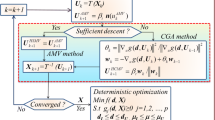Abstract
In the present work, some symmetry theorems for structural optimization problems involving reliability measure and bi-modulus materials are established. In the first part of this paper, two types of symmetric reliability-based structural optimization problems are discussed. It is proved that, for the first type symmetric RBDO problems, the existence of symmetric global optimal solutions can be guaranteed even through the probability density function (PDF) is non-symmetric. While for the second type symmetric RBDO problems, more severe conditions on PDF are required to ensure the existence of symmetric global optimal solutions. In the second part of the paper, the convexity of the compliance of truss structures involving bi-modulus materials is confirmed firstly. Based on this result, it is found that for both deterministic and robust symmetric compliance minimization of truss structures involving bi-modulus materials, symmetric global optima always exist. The theoretical results are also demonstrated through some academic examples.









Similar content being viewed by others
References
Armstrong MA (1988) Groups and symmetry. Springer
Boyd S, Vandenberghe L (2004) Convex optimization. Cambridge University Press
Cheng GD, Liu XF (2011) Discussion on symmetry of optimum topology design. Struct Multidiscip Optim 44:713–717
Cheng GD, Xu L, Jiang L (2006) A sequential approximate programming strategy for reliability-based structural optimization. Comput Struct 84:1353–1367
Ching J, Hsu WC (2008) Transforming reliability limit-state constraints into deterministic limit-state constraints. Struct Saf 30:11–33
Du ZL, Guo X (2014) Variational principles and the related bounding theorems for bi-modulus materials. J Mech Phys Solids 73:183–211
Frangopol DM, Maute K (2003) Life-cycle reliability-based optimization of civil and aerospace structures. Comput Struct 81:397–410
Guo X, Ni CH, Cheng GD, Du ZL (2012) Some symmetry results for optimal solutions in structural optimization. Struct Multidiscip Optim 46:631–645
Guo X, Du ZL, Cheng GD, Ni CH (2013) Symmetry properties in structural optimization: some extensions. Struct Multidiscip Optim 47:783–794
Guo X, Du ZL, Cheng GD (2014) A confirmation of a conjecture on the existence of symmetric optimal solution under multiple loads. Struct Multidiscip Optim 50:659–661
Kanno Y, Ohsaki M, Katoh N (2002) Symmetricity of the solution of semi-definite programming. Struct Multidiscip Optim 24:225–232
Nikolaidis E, Burdisso R (1988) Reliability based optimization: a safety index approach. Comput Struct 28:781–788
Richardson JN, Adriaenssens S, Bouillard P, Coelho RF (2013) Symmetry and asymmetry of solutions in discrete variable structural optimization. Struct Multidiscip Optim 47:631–643
Rozvany GIN (2011) On symmetry and non-uniqueness in exact topology optimization. Struct Multidiscip Optim 43:297–317
Rozvany GIN, Maute K (2011) Analytical and numerical solutions for a reliability-based benchmark example. Struct Multidiscip Optim 43:745–753
Rozvany GIN, Pomezanski V, Sokol T (2014) Exact compliance-based multi-load truss topology optimization revisited – also background material for an authors’ reply to a discussion by logo. Struct Multidiscip Optim 50:193–205
Stolpe M (2010) On some fundamental properties of structural topology optimization problems. Struct Multidiscip Optim 41:661–670
Svanberg K (1994) On the convexity and concavity of compliances. Struct Optim 7:42–46
Tu J, Choi KK, Park YH (1999) A new study on reliability-based design optimization. J Mech Des ASME 121:557–564
Watada R, Ohsaki M, Kanno Y (2011) Non-uniqueness and symmetry of optimal topology of a shell for minimum compliance. Struct Multidiscip Optim 43:459–471
Yang RJ, Gu L (2004) Experience with approximate reliability-based optimization methods. Struct Multidiscip Optim 26:152–159
Youn BD, Choi KK, Park YH (2003) Hybrid analysis method for reliability-based design optimization. J Mech Des ASME 125:221–232
Acknowledgments
The financial supports from the National Natural Science Foundation (10925209, 91216201 and 11372004), Program for Changjiang Scholars, Innovative Research Team in University (PCSIRT) and 111 Project (B14013) are gratefully acknowledged.
Author information
Authors and Affiliations
Corresponding author
Appendix A
Appendix A
In this appendix, we shall prove the fact that
The augmented Lagrangian function of the optimization in (38) is
Where λ ∈ Λ and Λ = {(λ 1, …, λ n )⊤|λ i ≥ 0, i = 1, …, n}.
Accordingly, the Karush-Kuhn-Tucker (K-K-T) conditions of \( \underset{{\mathcal{U}}^{ad}\times {\mathcal{Z}}^{ad}}{ \max}\left(-2\Pi \left(\boldsymbol{u},\boldsymbol{z};\boldsymbol{A}\right)\right) \) can be written as:
On the other hand, the K-K-T conditions of the optimization problem \( \underset{{\mathcal{U}}^{ad}\times {\mathcal{Z}}^{ad}}{ \max}\Pi \left(\boldsymbol{u},\boldsymbol{z};{\mathbf{\mathcal{R}}}^i\boldsymbol{A}\right) \) are:
Then with use of the following relations
(52) can be simplified as:
Since the external force is symmetric, i.e., f = R ⊤ u f, it can be verified immediately that the \( {\boldsymbol{u}}_R^{*}={\mathbf{R}}_{\mathbf{u}}^{\top }{\boldsymbol{u}}^{*}\in {\mathcal{U}}^{ad},\ {\boldsymbol{z}}_R^{*}={\mathbf{R}}_{\mathbf{z}}^{\top }{\boldsymbol{z}}^{*}\in {\mathcal{Z}}^{ad} \) and λ * R = R ⊤ z λ* ∈ Λ do satisfy (54) by taking (52) into consideration. Finally, since \( \Pi \left(\boldsymbol{u},\boldsymbol{z};{\mathbf{\mathcal{R}}}^i\boldsymbol{A}\right) \) is strictly convex in u and z jointly, then it can be concluded that \( \left({\mathbf{\mathcal{R}}}^i{\boldsymbol{u}}^{*},{\mathbf{\mathcal{R}}}^i{\boldsymbol{z}}^{*}\right)\in \mathrm{A}\mathrm{r}\mathrm{g}{ \max}_{{\mathcal{U}}^{ad}\times {\mathcal{Z}}^{ad}}\left(-2\Pi \left(\boldsymbol{u},\boldsymbol{z};{\mathbf{\mathcal{R}}}^i\boldsymbol{A}\right)\right) \)
Rights and permissions
About this article
Cite this article
Du, Z., Guo, X. Symmetry analysis for structural optimization problems involving reliability measure and bi-modulus materials. Struct Multidisc Optim 53, 973–984 (2016). https://doi.org/10.1007/s00158-015-1327-8
Received:
Revised:
Accepted:
Published:
Issue Date:
DOI: https://doi.org/10.1007/s00158-015-1327-8




